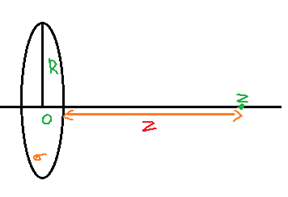
Answer
379.3k+ views
Hint: Suppose if a circular disc has a surface charge density, it will produce an electric field along the axis. The field strength varies as we go from the surface to a point in the axis.
Complete step by step answer:

Suppose a circular disc of radius R and has a surface charge density of $\text{ }\!\!\sigma\!\!\text{ }$, then the electric field at a point on the axis at a distance z from the disc is given by,
$E=k\sigma 2\pi \left[ 1-\dfrac{z}{\sqrt{{{z}^{2}}+{{R}^{2}}}} \right]$
Where, k is the coulomb’s constant, whose value is given by $\dfrac{1}{4\pi {{\varepsilon }_{0}}}$.
If the charge density is considered to be positive, the field will be along the axis directed away from the disc.
So if the point z is very close to the disc, such that z<$E=k\sigma 2\pi \left[ 1-\dfrac{1}{\sqrt{1+\dfrac{{{R}^{2}}}{{{z}^{2}}}}} \right]$
Since the ratio $\dfrac{{{R}^{2}}}{{{z}^{2}}}>>1$ is very much greater than 1, then we can write $\left( 1+\dfrac{{{R}^{2}}}{{{z}^{2}}} \right)$ as $\dfrac{{{R}^{2}}}{{{z}^{2}}}$. The reciprocal of this term will be less than 1 and can be neglected.
So the electric field of the disc at point z after the above approximation can be written as,
$E=k\sigma 2\pi \left[ 1-\dfrac{{{z}^{2}}}{{{R}^{2}}} \right]=k\sigma 2\pi $
Since the ratio, $\dfrac{{{z}^{2}}}{{{R}^{2}}}$ is very less and close to zero, thus neglected.
$E=\dfrac{\sigma 2\pi }{4\pi {{\varepsilon }_{0}}}$
$\therefore E=\dfrac{\sigma }{2{{\varepsilon }_{0}}}$
Therefore, the answer to the question is option (A)- $E=\dfrac{\sigma }{2{{\varepsilon }_{0}}}$
Note:
The electric field produced by a uniform disc of surface charge density $\left( \sigma \right)$ at a distance very far away from the disc behaves like an electric field produced by a point charge. $E=\dfrac{Q}{4\pi {{\varepsilon }_{0}}{{z}^{2}}}$, z is the distance on the axis which is very far away from the disc.
The electric field of a disc of charge can be found by superposing the point charge fields of infinitesimal charge elements. It can be facilitated by summing the fields of charged rings.
Complete step by step answer:

Suppose a circular disc of radius R and has a surface charge density of $\text{ }\!\!\sigma\!\!\text{ }$, then the electric field at a point on the axis at a distance z from the disc is given by,
$E=k\sigma 2\pi \left[ 1-\dfrac{z}{\sqrt{{{z}^{2}}+{{R}^{2}}}} \right]$
Where, k is the coulomb’s constant, whose value is given by $\dfrac{1}{4\pi {{\varepsilon }_{0}}}$.
If the charge density is considered to be positive, the field will be along the axis directed away from the disc.
So if the point z is very close to the disc, such that z<
Since the ratio $\dfrac{{{R}^{2}}}{{{z}^{2}}}>>1$ is very much greater than 1, then we can write $\left( 1+\dfrac{{{R}^{2}}}{{{z}^{2}}} \right)$ as $\dfrac{{{R}^{2}}}{{{z}^{2}}}$. The reciprocal of this term will be less than 1 and can be neglected.
So the electric field of the disc at point z after the above approximation can be written as,
$E=k\sigma 2\pi \left[ 1-\dfrac{{{z}^{2}}}{{{R}^{2}}} \right]=k\sigma 2\pi $
Since the ratio, $\dfrac{{{z}^{2}}}{{{R}^{2}}}$ is very less and close to zero, thus neglected.
$E=\dfrac{\sigma 2\pi }{4\pi {{\varepsilon }_{0}}}$
$\therefore E=\dfrac{\sigma }{2{{\varepsilon }_{0}}}$
Therefore, the answer to the question is option (A)- $E=\dfrac{\sigma }{2{{\varepsilon }_{0}}}$
Note:
The electric field produced by a uniform disc of surface charge density $\left( \sigma \right)$ at a distance very far away from the disc behaves like an electric field produced by a point charge. $E=\dfrac{Q}{4\pi {{\varepsilon }_{0}}{{z}^{2}}}$, z is the distance on the axis which is very far away from the disc.
The electric field of a disc of charge can be found by superposing the point charge fields of infinitesimal charge elements. It can be facilitated by summing the fields of charged rings.
Recently Updated Pages
Name the scale on which the destructive energy of an class 11 physics JEE_Main

Write an article on the need and importance of sports class 10 english JEE_Main

Choose the exact meaning of the given idiomphrase The class 9 english JEE_Main

Choose the one which best expresses the meaning of class 9 english JEE_Main

What does a hydrometer consist of A A cylindrical stem class 9 physics JEE_Main

A motorcyclist of mass m is to negotiate a curve of class 9 physics JEE_Main

Other Pages
Why does capacitor block DC and allow AC class 12 physics JEE_Main

The bond order of ClO bond in ClO4 ion and the effective class 11 chemistry JEE_Main

If a wire of resistance R is stretched to double of class 12 physics JEE_Main

Differentiate between homogeneous and heterogeneous class 12 chemistry JEE_Main

Derive an expression for maximum speed of a car on class 11 physics JEE_Main

Electric field due to uniformly charged sphere class 12 physics JEE_Main



